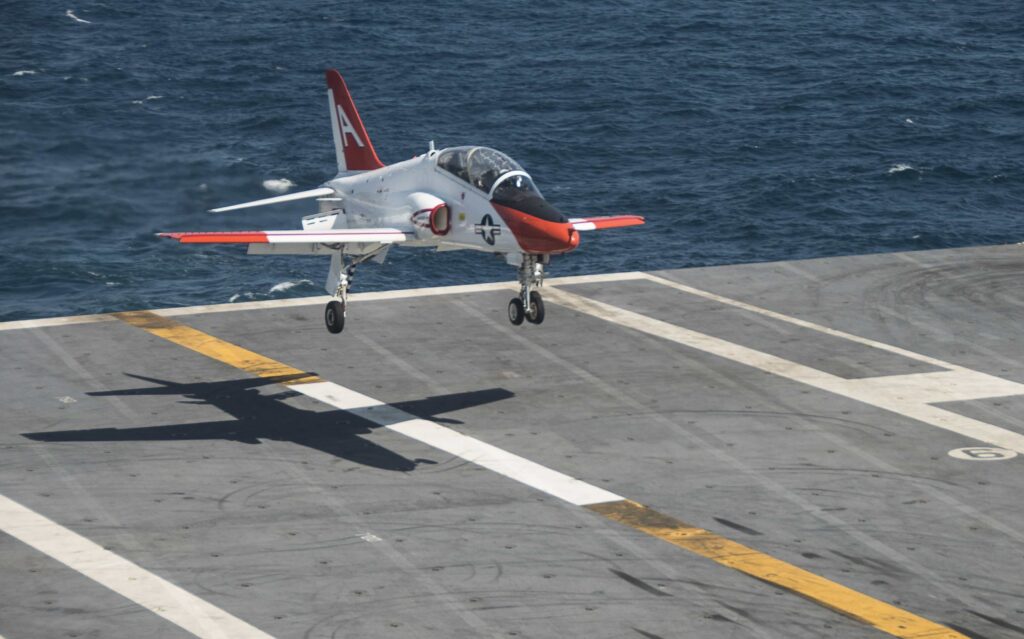This month marks the 25th anniversary of my qualifying as a naval aviator and earning my “wings of gold.” The journey to those wings was longer than most due to several factors, but the one set of circumstances that had the largest impact on me and my growth as a leader was my aircraft accident. This short series of articles aims to share the details and what I learned from the incident. My aspiration is that others can learn from my experience, both in terms of what not to do and to offer grounds for hope when life hands you a challenge.
On the day of my initial carrier qualification flight in December 1997, I awoke at 0325 for a 0500 course rules brief. During the rundown of our procedures, the assigned primary divert field was Naval Air Station (NAS) Cecil Field, the airstrip from which my flight would depart. The secondary was a Navy field on the coast.
Following a flight briefing at 0600, I took off in my T-45 Goshawk toward the carrier off the Florida coast along with two fellow students in their jets and our instructor, who flew in the lead aircraft. Upon arrival, we circled overhead between cloud layers and tuned in to the tower frequency below. As we orbited, we listened in on an unfolding situation below, where a peer ejected from his Goshawk that caught fire. Immediately, we were rerouted back to NAS Cecil Field, arriving at 1015.
After a break for a nutritious lunch at the golden arches, we attended an impromptu all-officers meeting to discuss the mishap and were asked if we felt safe to head back to the boat that afternoon. At the end of the meeting, we briefed for a second launch to the boat, and at 1500 took off once again for the carrier.
Upon arriving at the carrier, we received a “Charlie” signal – the indication to begin our descent into the traffic pattern – where I made two “touch and go” landings. My two ensuing passes were made “hook-down;” however, I was waved off both times due to poor landing parameters. At this point, I was at bingo fuel – a crucial state with just enough gas to fly back to NAS Cecil Field, make one approach and one full-stop landing. The tower directed me to proceed back to shore with an emergency bingo divert profile and, unbeknownst to me at the time, a lead/safe instructor was assigned to join me and escort me back.
Our join-up was delayed due to poor weather and issues with my radio and tactical air navigation systems. When we finally rendezvoused, the instructor took over external communications but continued as my wingman in the formation flight. The instructor rerouted us toward NAS Mayport, the Navy facility on the coast. Although I had sufficient fuel to safely execute an approach into NAS Cecil – the launch point with which I was more familiar – I accepted the change in plans.
We descended and broke out of the weather and into the clear at about 2,600 feet, over water, with the runway visible 10 miles in the distance. The instructor reminded me to drop my landing gear and flaps at seven miles. I was oblivious at this point. I had failed to perform my “feet-dry” checklist prior to the approach, and, on short final, I did a cursory execution of my landing checks by verifying that my gear and flaps were down and my speed brakes extended. I was more surprised to note that the airfield did not have a Fresnel lens – a visual landing aid particular to naval facilities and carriers – and the pavement appeared wet.
I touched down nearly 2,000 feet from the approach end of the runway and hit the brakes while rolling out at 115 knots. At the time, I was unaware that the starboard main landing tire blew, which caused my jet to start yawing to the right. My attempts to counter the swerve were ineffective, and the Goshawk departed the runway. As the T-45 flipped over and green grass enwreathed my aircraft canopy, I remember thinking, “This is it… this is how I am going out.”
As the plane impacted the ground, my legs struck the instrument panel. Fortunately, I only suffered minor lacerations and abrasions from the crash and the shattered canopy. While taking an inventory of my limbs and senses, I realized the instructor had directed me to contact the tower on the landing rollout. So, I made a cursory attempt to tune up their communication frequency and let them know I was alive. However, despite my repeated attempts, they couldn’t hear me. So, I immediately began to prepare to crawl out of the aircraft. Providentially, my head was about an inch above the dirt, and there was enough space between the fractured canopy and the ground for me to squirm out of the wreckage. After a brief interlude to crawl back in and “safe” the ejection seat, the rescue crew strapped me to a gurney and wheeled me off to the hospital.
What I learned from this incident would help shape me as a person and influence my leadership throughout my career in the Navy. But the true value came from sharing my experience. As I break down these lessons, it is not only an opportunity to pass along this knowledge but an opportunity for reflection. What have been your biggest challenges? What have you learned on your journey?


